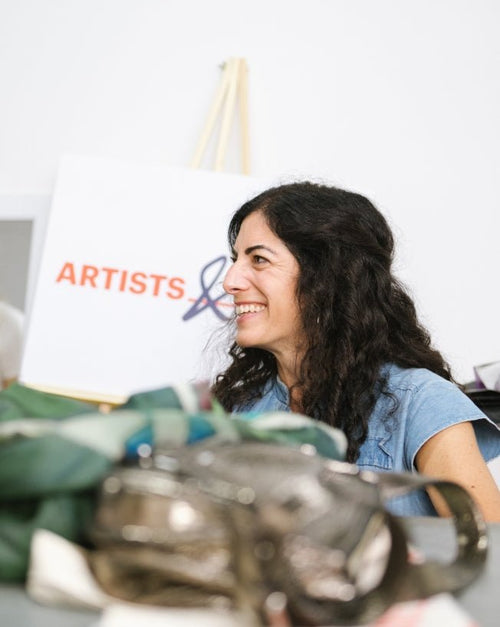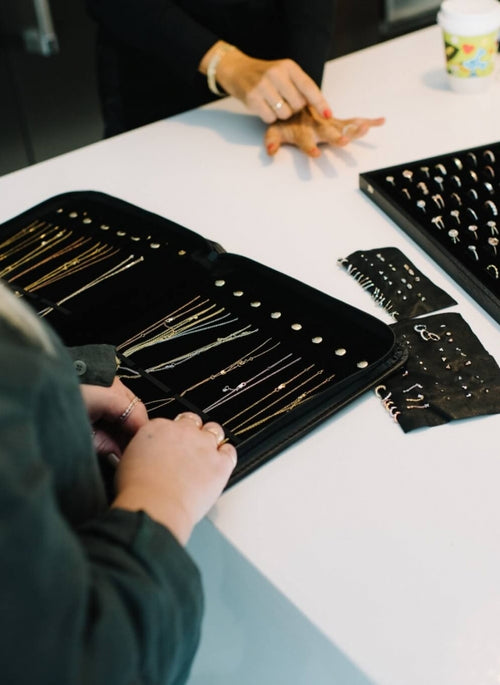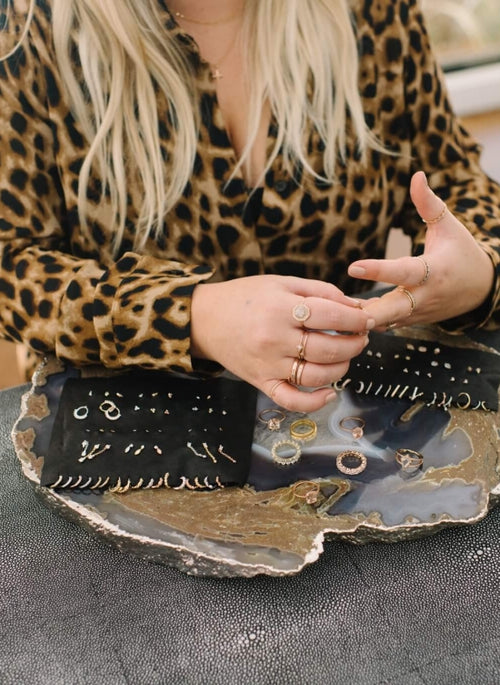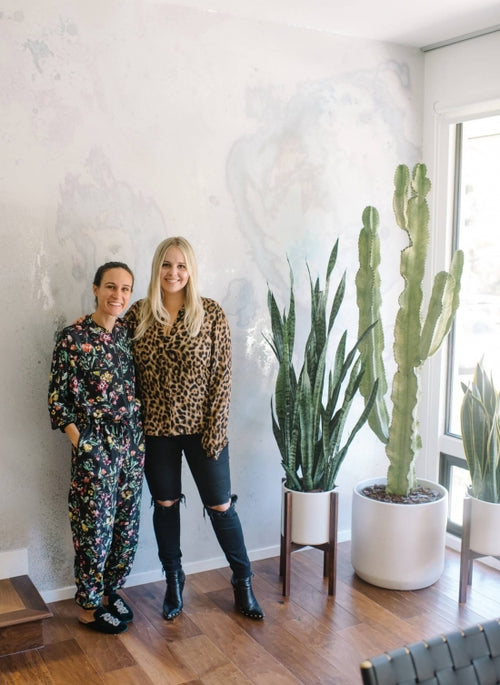Your cart is empty.
Let’s find your perfect shade.

Cart (0)
Your cart is empty.
Let’s find your perfect shade.
A lot of talent and a chance meeting paved the way to two incredibly beautiful and successful jewelry lines. Amanda Thomas, the creator of LuvAJ and Après, is not only an amazing young talent and total #girlboss, she is an absolute joy. Her collection Après, designed for the modern bride and her bridal party, fills the void of affordable yet trendy and well-designed wedding jewels.
MELISSA: What is Après?
AMANDA: The main core of Après, is it is supposed to be alternative bridal, but also stuff that you are supposed to wear every day, too. A lot of the earrings and necklaces are between $75 and $500. They are great bridesmaid gifts too! I would get a lot of girls asking about LuvAJ, asking if I could do it in real gold because they wanted to give it to their bridesmaids. Girls don’t want to give their bridesmaids something cheap, they want to give them something nice. But, it’s at the end of the wedding and they have blown their budget so they aren’t really spending over $150. There are a ton of options that work at that price point.
MELISSA: While LuvAJ is pretty well-known, Après is pretty young. How are things going with it?
AMANDA: I’ve gotten some really good feedback so far but it’s people who have seen the site, bookmarked it, and are thinking about it. The purchases don’t flow as much as LuvAJ does, because those are so easy, $100. I just did a bunch of deskside meetings in New York, with bridal magazines, which I’ve never worked with before and I got amazing feedback. Everyone said this is exactly what they were looking for: cool, modern, and affordable bridal jewelry. There really isn’t that much out there.
MELISSA: Where does your love of jewelry come from?
AMANDA: When I was in high school, I grew up in LA, and my mom told me I either had to get an after-school job or an internship. Internship sounded like way more fun. My cousin knew this jewelry and clothing designer that worked on Abbot Kinney. Her name is Natalie and I started working for her. I was 14 at the time. My dad would drop me off after school and I would help her out with whatever she needed. She was just so cool, so creative. Everything she did was one-of-a-kind. All her jewelry was reappropriated vintage. She would buy crazy brooches and chains and put them all together. Everything looked like sunken treasure. She taught me the basics of jewelry making, which is wire wrapping. From there, I started making my own stuff on the weekends. I would go to the bead store, just really simple pieces I would wear to school. Girls started noticing it. I started doing everyone’s jewelry for prom. From there, I just started making it for fun and selling it to friends, but nothing crazy.
MELISSA: When did it get crazy?
AMANDA: I was in Fred Segal with my sister shopping and a buyer stopped me and said “Oh my god I love you necklace. Where did you get it?”. When I told her I made it she asked if I had anymore. I told her yes. That was first buyers meeting. She asked if I could come back the next week with my collection. I said sure! I went home and said I had a meeting with the buyer at Fred Segal. My mom was like “Oh my god!”. I spent the whole weekend making as much as I could with all my materials. I went and they picked up everything. They were my first retailer. I had to learn about invoicing, consignment, terms. I didn’t know anything. I was 14. I didn’t have a car.
MELISSA: Your big break happened in a chance meeting. Did you know then that you wanted to be a jewelry designer?
AMANDA: From there, once I had Fred Segal, it was the key to open everything. I started going to Madison, Ron Herman, Lisa Kline, Kitson. I’d walk in and say, “Hi, I’m in Fred Segal. Would you like to see my line?”. They all picked me up. Everyone thought I was so cute because I was a high schooler making all this stuff. It started in high school, and throughout high school and college, every summer I did a different internship. Not even jewelry. I worked for a stylist, I worked for a PR firm. I worked for Who What Wear. I worked for Rachel Zoe. I worked for Rachel Pally. I didn’t know what I wanted to do. Maybe I wanted to be a clothing designer. Maybe I want to work in PR. Maybe I want to be a stylist. So I just worked every single summer. I ended up crossing everything off my list and at the end, I decided I wanted to do jewelry.
MELISSA: How quickly did things fall into place once you decided to design jewelry full time?
AMANDA: My senior year of college I decided that once I graduated, I would pursue it [jewelry]. I was at Who What Wear at the time. I had become really close to the founders Hillary and Katherine. When I left they asked me to tell them when my next collection was out, to send it through, and that they would feature it in a story. I sent it and they surprised me and did an entire story on me. This was back in the day when they did singular ones. They did a story called “Line We Love: LuvAJ”. That was the day everything just changed. That morning I got an email from Nordstrom! Urban Outfitters picked it up for every retailer in the US and offered me to do a capsule collection as well. I got into Shopbop. I was making everything by hand myself. That’s when I had to put my big girl pants on and figure it out. I started hiring helpers and had to find a factory. Figure out how to run a business. Luckily my parents are entrepreneurs, had some background, and could guide me in the right direction. I’ve been doing it fulltime since then and that was 2011, 6 years ago now.
MELISSA: What’s your process? Do you design everything and send it to the manufacturer? Do you sketch it out, have an idea?
AMANDA: I produce overseas now. I switched over a couple years ago which was the best thing I’ve ever done. Now I design a year in advance. I am doing Holiday 2018 right now. I run a lot of reports to see what is selling for me and what is selling for my future seasons. Right now we are sold through spring. So I know what people are buying. I try to add all those silhouettes in, then try to forecast what I think is going to be cool, which usually works, because I am a little edgier than my customer.
MELISSA: Where do you get the diamonds? Where do you source them?
AMANDA: Dealers in downtown LA. Based on what people are looking for, I work one-on-one with whoever it is I am making the ring for. It mainly starts with a budget. Once I know your budget, I try to get you the best diamond humanly possible. There are certain color and clarity that I won’t go below because it doesn’t look good.
MELISSA: Do they wear different? Are morganite or white sapphire as durable?
AMANDA: On my site, there are charts that explain what is a morganite, what is a white sapphire. What is the difference between those and diamonds? Essentially, those three stones all have very similar hardnesses, which means they are super durable. They aren’t going to crack. The difference is diamonds have an effervescent, a rainbow quality. White sapphire and morganite do not. It is more see-thru, whereas diamonds truly sparkle.
MELISSA: What is your favorite material to work with?
AMANDA: Metal. I don’t really use a ton of stones. I get overwhelmed with the possibilities. I like the simplicity of metal. Whether it is a chain or doing a pendant.
MELISSA: Where do you get your inspiration?
AMANDA: A little bit of everywhere. I feel like I’ve gotten a good system down. Between seasons I am constantly collecting imagery, whether it is on Instagram, I do a ton of Pinteresting. Additionally, on Pinterest, I look at a lot of museum’s photos that have vintage jewelry. My dad has a library of his own. He has a ton of vintage jewelry books. He always gives me them. I’ll find cool little motifs that inspire the collections.
MELISSA: Go-to accessory, something you don’t leave the house without?
AMANDA: I always have some sort of cross or cross earrings on. I love them. I do a different iteration every season of crosses. I think they are so beautiful. They don’t even need to be religious. They aren’t really for me. I just love the shape and the possibilities of how many different styles and versions you can do. They are my number one selling style.
MELISSA: If we were to raid your closet, what type of accessory would we find the most of?
AMANDA: Shoes. You will laugh at me. It’s obscene. I went through a phase in my early 20s and I had to have whatever the “it” shoe was. So I have some really crazy, crazy kicks.
MELISSA: What jewelry trend are you loving most this season?
AMANDA: The choker is gone. The look right now is multi-layered charm necklaces that look like you found from all different places and put them together. That is one thing we always sell. I do a lot of complete sets, whether it is mismatched earring sets that are all different, showing that this is how you are supposed to wear them. I’ll do necklaces, 5 or 6 layers, a coin necklace, dangling things, but they are just one altogether. It takes the guesswork out. It is all perfectly layered.


